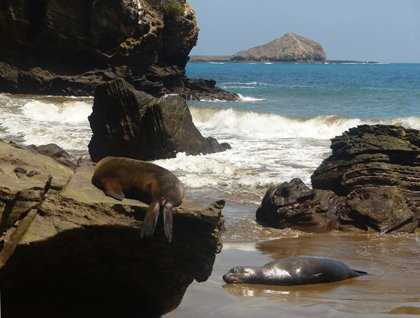Punta Pitt, the farthest eastern point of land in all of Galapagos, was possibly the first glimpse of the archipelago had by Charles Darwin and the crew of the H.M. S Beagle in 1835. It was named in honor of William Pitt, first earl of Chatham, a politician renowned for his opposition to corruption in government and his support for the colonial position during the American War of Independence; it was also known simply as “Pitt” or “Chatham” during his heyday. The English name of the island is Chatham, but when the archipelago was claimed by the Ecuadorians in 1832, it was given the name San Cristobal after the patron saint of travelers, Saint Christopher.
Punta Pitt itself is the eroded remnant of what originally would have been a massive tuff cone. After over 400,000 years of occasional heavy rain (depending on the El Niño Southern Oscillation – ENSO - events), it is now a spectacular ravine-riddled mountain that in low, early light is one of the most dramatic sights in the islands.
Up one of the ravine beds we went, up to a plateau at about 320 feet. The trail then leads inland and finally out towards the outer bluff above the ocean, and it is here that we found our objective: the red-footed boobies. A few pairs were scattered and perched in the dry bushes and trees, blue-footed boobies were courting on the ground, and Nazca boobies were standing on the far outer rocks, right next to the water. This is one of the few places in the Galapagos where all three species of resident boobies are known to nest…and we saw all three doing just that! In fact, one nest of blue-footed boobies even had three eggs in it…a fabulous bit of news, considering we haven’t seen a nest with three eggs in a few years. Do they know something we don’t know? I suspect they do.
The golden-green beach with flecks of feldspar and mica sparking in the sunlight, was perfect for cooling off after the walk. However the afternoon beach at Cerro Brujo was the highlight for body-surfing, a final Galapagos de-compression stop before returning to the civilized world of home, school and work. In the distance, the setting sun approached the iconic silhouette of Leon Dormido just off-shore.
Our walk back to the pick-up beach had one last amazing Galapagos experience for us: two young sea lions had chosen to snooze in a narrow fissure in the lava. Our only passage to the Zodiacs required us to STEP OVER one of the sea lions. So we did, once more blown away by the innocent trust of these wild animals. They truly believed we would do them no harm, and so continued their half-sleep as over 80 people stepped over them on the way to the pick-up beach.
That’s Galapagos. That’s why I’m still here.
By sunset though, we were all on board, showered and changed and enjoying the wonderful bow of the National Geographic Endeavour as the Captain brought her slowly towards this awe-inspiring piece of Galapagos geology. Just as the sun set, we caught the final rays through the narrow fissure that splits this rock in two.
A fitting farewell. Part of our soul and spirit will stay in these free, enchanted islands, while the rest continues back to civilization and a modern world.







